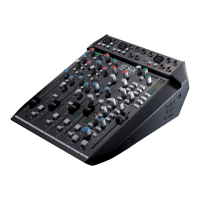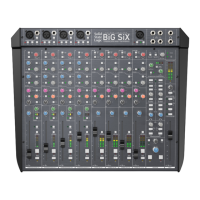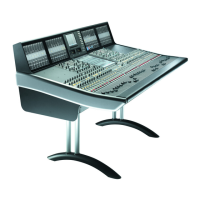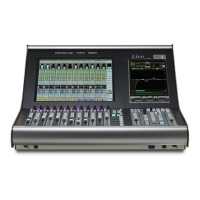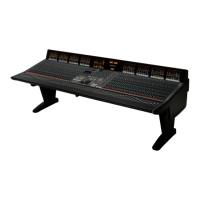Digital I/O
Matrix has one stereo digital output which feeds both AES/EBU and S/PDIF connections on the desk’s rear
panel. This output is controlled by the
Digital I/O area of the centre section, located immediately below the
MIX bus master. If a digital input is connected, then Matrix will lock its internal clock to it. The LED in the top
right corner of the
Digital I/O area, labelled ADC LOCK, lights to indicate that the desk is locked to the
incoming signal.
The digital output can be sourced from the
MIX bus, REC bus, or from the monitor signal (pre-monitor level). The SOURCE
button cycles through these options, and LEDs to the right of the button indicate which source is selected. If there is an incoming
digital signal, the output will replicate its sample rate. If no digital input is detected the output sample rate will default to 48kHz
- it is recommended that an external reference is always connected to ensure that Matrix’s digital I/O remains synchronised to
the DAW.
The FX SEND Busses
Each of the four FX signals can be auditioned on the main monitoring by pressing the AFL button below the
gain pot. There is an LED to the right of the button which lights to indicate that
AFL is on. (See Page 39 for
more on
AFLs.)
Stereo Returns
The outputs of the devices connected to the four
FX sends would normally be brought back into Matrix using the
line-level Stereo Returns, labelled
ST RET 1 to ST RET 4. These are located below the REC, CUE ST and
FX bus master controls.
The top three buttons allow you to route the signal to the
MIX, REC and CUE ST busses. An LED to the
right of each button lights to indicate the presence of this routing.
The signal can be summed to mono by pressing the
MONO button below the three routing buttons. An LED
to the right of the button lights to indicate that the signal has been reduced to mono.
Below the
MONO button is a pot which functions as a balance pot for stereo signals and a pan pot for mono
signals, and at the bottom of each
ST RET area there is a gain trim. Both of these pots have Total Recall LEDs.
The signal can be auditioned on the main monitors by pressing the
AFL button below the gain pot. There is
an LED to the right of the button which lights to indicate that
AFL is on. (See Page 39 for more on AFLs.)
Chapter 3 - Analogue Signal Flow
38
Matrix
2
Owner’s Manual
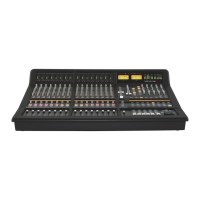
